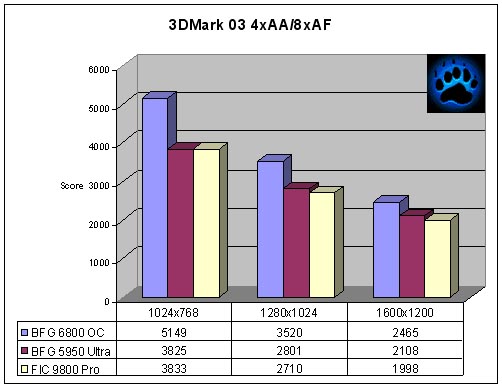Are you itching to upgrade that 5900 series or 9800 Pro but just can’t afford the $500 price tag of the latest and greatest. Take a look at the BFG 6800 OC and see if the lower end of the totem pole can still satisfy that yearning for a new engine in your PC.
Introduction
The war between the graphics giants will go on and on for eternity at this point, so the biggest news is always who has the biggest weapon at the time. There always seems to be someone with a bigger gun, but finding out just how much more heat the competitor is packing is becoming more and more of a challenge. Enter NVIDIA’s big gun — the 6800 series of video cards. These feature and performance packed cards are making a very big splash on the gaming scene with the introduction of games such as Doom 3 taxing your graphics with a fury nobody has seen before. What’s even better about the 6800 series is its ability to have the same technology at all levels of their products, just having toned down some of the speed on the lower end. Today we are going to look at another Big F#$^@* Gun on the market (no pun intended) with the BFG GeForce 6800OC, the OC meaning overclocked right out of the box. This is the lowest end of the 6800 series cards and features only 128MB of memory on board.
Specs and Features
The biggest difference between the standard 6800 and its big brothers the GT and the Ultra is the slower clock speed and the fewer pipelines. All the same technology is there, just not the extra speed pushers to go along with it. The nice thing about that is the huge price tag doesn’t go along with it either, keeping the standard 6800 within reach of the general working man. Shall we take a look at some specs and features……sure why not.
Specs
- GPU NVIDIA® GeForce 6800
- Bus Type AGP
- Memory 128MB DDR
- Core Clock 350MHz (vs. 325MHZ standard)
- Memory Clock 700MHz (effective)
- RAMDAC Dual 400MHz
- API Support Microsoft® DirectX® 9.0, OpenGL for Microsoft® Windows®
- Connectors VGA, DVI, S-Video-Out
- 438 million vertices/sec setup
- 22.4GB/second memory bandwidth
Features
- Custom BFG cooling solution with polished nickel finish and dual blue LED lights
- Superscalar GPU architecture
- NVIDIA® CineFX(TM) 3.0 engine
- On-chip video processor
- NVIDIA® UltraShadow(TM) II technology
- 64-bit texture filtering and blending
- NVIDIA® Intellisample(TM) 3.0 technology
- NVIDIA® ForceWare(TM) Unified Driver Architecture (UDA)
- NVIDIA® nView(TM) multi-display technology
- NVIDIA® Digital Vibrance Control(TM) 3.0
- AGP 8X
- Microsoft® DirectX® 9.0 Shader Model 3.0 support
What’s in the box?
- BFG GeForce 6800 OC graphics card
- Quick install manual
- DVI-I to VGA connector
- Y power cable
- Driver CD, which includes
- NVIDIA® Unified Drivers
- Full installation manual .pdf
- NVIDIA® NVDVD 2.0 multimedia software
- Windowblinds BFG / NVIDIA® skins
Why don’t we try to clear up a couple of things really quick before we get too far ahead of ourselves. As I stated before, each of the 6800 cards in the entire 6800 line feature the same technology but have differences in clock speeds, memory, and pipelines on each card.
Just to give you somewhat of an idea on the differences between the standard 6800 and its bigger brothers the GT and Ultra, here is a simple chart that shows memory, pipeline, and clock speeds of the three choices in the lineup.
| Card | Memory | Pipelines | Speed (core/memory) |
| GeForce 6800Ultra | 256MB GDDR3 | 16 pipelines | 400MHz/1.1GHz |
| GeForce 6800GT | 256MB GDDR3 | 16 pipelines | 350MHz/1GHz |
| GeForce 6800 | 128MB GDDR | 12 pipelines | 325MHz/700MHz |
What you do need to remember about the 6800 OC is that it has already been jumped up to 350Mhz on the core speed straight out of the box. This card is overclocked before you even put it in your PC.
Right out of the box, the BFG 6800 OC is a big boy. There is no doubt the cards are still quite the bricks of the PC world. Hefty and large are key words to describe the overall size and stature of the 6800 OC. The biggest eye-catcher on the card is the cooling unit that makes up a massive portion of the card. The polished surface, dual fans, and copper heatsinks show you there is no monkey business going on around at BFG when it comes to making sure this thing doesn’t make your PC a steam room for your other PC parts. The cooling piece is somewhat bulky but attractive and functional at the same time. It gets the job done, and that’s what is most important.
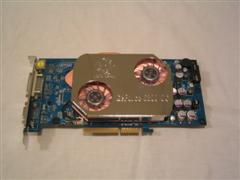 |
 |
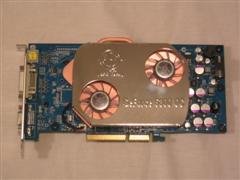 |
The standard connections are all present and accounted for on the 6800 OC. VGA, DVI, and S-Video are all reporting and ready for duty. I use a 20″ Dell LCD, so DVI is a must-have for me now. I wouldn’t have had a second thought about it prior to owning an LCD, but now there is no going back to the standard VGA for me. If you have an LCD and haven’t made the switch give it a try, go DVI.
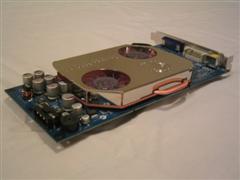 |
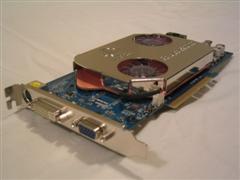 |
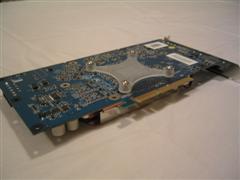 |
Inside the box was the card, driver CDs, demos of Splinter Cell Pandora Tomorrow, Silent Storm, and Painkiller, and even a full copy of Far Cry. Not a bad bundle compared to many of today’s cards. There is also a DVI to VGA adapter and a Y molex connection if you need them.
|
FIND THE BEST PRICES FOR BFG 6800 VideoCards AT PRICEGRABBER |
Installation
I had no troubles whatsoever when installing the card into my case. The 6800 OC has gotten rid of the two-slot-takeover seen with the 5900 series of cards, but the bulk of it would still keep me from moving any PCI peripheral directly underneath the card. Of course the AGP cards have not gotten away from needing an external power source, so the standard four pin molex connection on the back is still a must for a card this powerful.
Upon starting my machine up, I was pleasantly surprised that this card did not add much noise to my case. The cooling system is relatively quiet compared to the rest of the components in my case. If I were using a larger HSF on my CPU, it would probably drown out this card it is so quiet. It is great to see that with the added power you don’t have to add earplugs to your arsenal as well.
NVIDIA Forceware drivers 61.77 were rockin’ and rollin’, and this card was on its way. Then something caught my eye. Is that an eerie blue glow coming from inside my PC now??? Yup, the fans on the BFG 6800 OC have blue LEDs on them and cast a sweet little blue hue on the inside of your case. An added little perk if you want your box to not only perform well, but look damn good at the same time. Two thumbs up to BFG on that call.
Testing
During testing, my main goal was to focus on the cards that many of you are probably using today and want to know if you should make that jump to the new line of 6800 cards while spending the least amount possible. Is the jump worth it? That is the question that I hope I can help you answer.
I used the Bench-Em-All application in order to run benchmarks on AquaMark3, 3DMark03, Codecreatures, Unreal Tournament 2004, and the newest card killer Doom 3. I wanted to run each card through the true brunt of testing by cranking up the settings to 4x Anti-Aliasing (4xAA) and 8x Anisotropic Filtering (8xAF) to really see what they can do. I then ran the same tests without the AA to see just how well they can play in the real world where everything can’t always be perfect (mucho eye candy in other words) although we want it to be.
The cards in the lineup are of course the BFG 6800 OC, its little brother the BFG 5950 Ultra 256MB, and to play from the other side of the tracks is the FIC 9800 Pro 256MB.
Let’s start off with the settings cranked up to 4xAA/8xAF and see how far these cards can float.
Test System:
- Leadtek K8N Pro Motherboard
- Athlon 64 3200+ @ 2.0Ghz
- 512 MB Corsair XMS PC3200 Memory (2x256MB)
- 2x80GB Hitachi SATA HDDs in RAID0
- Dell 2001FP 20″ LCD monitor
- NVIDIA 61.77 drivers
- ATI Catalyst 4.8 drivers

Right from the start, we can see in AquaMark3 and Codecreatures that the 6800 is more than up to the occasion. The numbers get closer and closer together as resolution increases. The 5950 and 9800 Pro have the advantage with the extra 128MB of memory on board allowing a little extra storage of textures and elements of the benchmark that the 128MB limit on the 6800 OC just can’t keep up with. It is obvious that we have a few more horsepower under the hood of the 6800 than its predecessors.
I’m starting to wonder if anyone will look at any other scores besides the Doom 3 numbers. This game has easily left every gamer stunned about how much you really need to run this game at its peak possibilities. This benchmark is simply a playback of a timed demo that is built into the game itself. Unfortunately, with that you cannot rely 100% on its ability to reproduce this performance in the actual game. As you can see, with the settings cranked up, the numbers were not fantastic by any means. The BFG 6800 OC definitely came out on top with numbers that would be “almost” playable to the least discerning of eyes. After 1024×768 though, good luck having an enjoyable experience with the settings juiced on this game. Maybe we will have better luck without the AA later.
Here we see a little bit of a surprise. The 9800 Pro pulled out the big guns and made a valiant effort to keep up with the 6800 OC in the UT 2004 test. Of course, all of these framerates are well above the needed amount to have an enjoyable gaming experience. No need to worry about keeping up with your favorite games of yesterday.
|
FIND THE BEST PRICES FOR BFG 6800 VideoCards AT PRICEGRABBER |
Testing (continued)
Now let’s take a look at how the 6800 OC stacks up without that pesky AA turned on. Pesky yes since it adversely affects performance, but oh man it makes games look so good. This will help give a better perspective on just how well things can be without all the glamour of AA in games.
The 6800 OC continues to strut its stuff and towers over the lower end cards in all the tests. The lack of memory on the 6800 OC has definitely not held it back in this batch of benchmarks. With 10-15 FPS differences in many of the scores, the 6800 OC is starting to head to the front of the class.
The 3DMark03 test shows a huge step up in performance. The 6800 OC is able to put up scores over 1000 points ahead of the 5950 and 9800 Pro at every resolution.
The 6800 OC was able to keep playable framerates at every resolution in the Doom 3 test. Yes, exactly 30 FPS may be a little on the low side for most in “playable” gaming, but it is well ahead of the 5950 and 9800 Pro with their framerates dropping into the teens and lower.
I think that UT 2004 may have finally reached its peak in benchmarking prowess. You can pretty much throw it into the mix and be guaranteed framerates well above 60 FPS at every resolution.
|
FIND THE BEST PRICES FOR BFG 6800 VideoCards AT PRICEGRABBER |
Overclocking
First things first with the 6800 OC. The card is already overclocked right out of the box from a stock 6800 core setting of 325MHz to 350MHz. Any numbers beyond this is overclocking that number even more. I went ahead and added the Coolbits registry mod to give me the option to adjust the clock settings from within the NVIDIA driver panel. I wanted first to see what the automatic detection of optimal settings would give me. The drivers came up with a 374MHz core setting and a 748MHz memory setting (up from the stock 700MHz). That is a relatively nice step up to start with so I ran the AquaMark3, 3DMark03, and Doom 3 tests at these settings with noAA/8AF.
As you can see, the overclocking didn’t make a huge amount of difference with a 24 and 48 MHz step up on the core and memory speeds, respectively. The most obvious differences came with the 3DMark03 tests. The AquaMark3 and Doom 3 tests on the other hand only increased by a few FPS.
I continued to increase the speeds into the 385/765, range but the performance increases continued to unimpress me. A couple of FPS increase was all the 6800 OC could muster up. There were also problems with the Doom 3 textures that were caused by the increased speed. I have seen several other reviews that achieved clocks all the way into the 400/800 range. The performance only increases a trivial amount as far as I’m concerned.
Playability
So there are a bunch of numbers to look through, but come on, how can you really use numbers to completely weigh a video card? With the playability section I want to give you a subjective view of what I think are the highs and lows of the actual gameplay of the card. How does it look compared to other cards and what can it do better and what does it do worse. Of course this is completely subjective and is based purely upon how I see things so take it for what it is worth to you.
A lot of people are wondering about Doom 3. Some people have even purchased a new card just to play this particular game. I have played Doom quite a bit with both the 5950 and 9800 Pro cards. I love the game and can tell you first hand that it wreaks havoc on graphics cards. So what can the 6800 OC do for you? I can easily play Doom 3 at 1024×768 with noAA/8AF on all three of the cards and they all look great. The memory difference with the 6800 OC is not a problem with Doom 3 as far as I’m concerned. It handled these settings with relative ease. Crank on the 2xAA and the 5950 and 9800 Pro just can’t really cut it. Yes, it’s playable but not that enjoyable due to the drop in framerates. The 6800 OC on the other hand can take the 2xAA a little better and most of the gameplay is smooth. The addition of the 2xAA makes a sweet amount of difference in the look of the game. More detailed texture and smoother lines make it even scarier than normal.
Another game that taxes the crap out of your card is FarCry. I have been playing this game quite a bit and yet again the 6800 OC does a pretty good job of increasing the gaming experience with a little extra eye candy. Settings that normally would have made the 5950 and 9800 slow down to a choppy mess are much smoother and playable with the 6800 OC.
Overall the 6800 OC did better on just about every test on the board. Can you really see these score differences? I say yes, depending on what you are playing. If you play a lot of Quake III and Unreal Tournament you really aren’t going to notice it that much. Considering that even at 1600×1200 you get framerates that are not even discernable to the human eye these games don’t see much of a change. If you are planning on hitting up games like Doom 3 and the latest offerings like FarCry, the 6800 OC can make a difference in your quality of gameplay.
|
FIND THE BEST PRICES FOR BFG 6800 VideoCards AT PRICEGRABBER |
Final Thoughts
There you have it folks. The BFG 6800 OC is a sweet card that offers great performance in nearly every end of the graphics spectrum. Yes, it may not be the GT or Ultra, but it definitely holds its own. If you do already own a GeForce 5900 series or a 9800 Pro video card, you may be more inclined to jump up a notch to the GT or Ultra or sit on your hands and wait for the next batch of cards to arrive.
If you are looking to upgrade and you are sitting on a 5700 or 9600 card, then the 6800 OC may be the ticket that you are looking for. The BFG 6800 OC is a great piece of hardware with top-notch performance. The biggest thing on most people’s minds is the price. The BFG 6800 OC can be found in the $300-$350 range. Not exactly cheap, but nowhere near the $450-$550 range the 6800 Ultra and Radeon X800 cards are running at this time.
The fact that BFG offers 24/7 tech support and a lifetime warranty only adds to the good points about this card. BFG seems to be putting out quality products one after the other.
Pros:
+ Good performance
+ Overclocked out of the box
+ Quiet and cool with some sweet LEDs
+ 24/7 tech support, lifetime warranty
Cons:
– Still pricey
– May be skipped over for GT or Ultra
If you are looking to upgrade from a lower end card, the BFG 6800 OC could be just the card you are looking for. It is a strong performer that will keep you and your wallet happy for a long time to come. With the influx of hyper graphic intensive games looming over the horizon, there may be no better time than the present to stick a new BFG 6800 card in your PC. I give the BFG 6800 OC an 8.5 out of 10 and the Bjorn3D Seal of Approval.
|
FIND THE BEST PRICES FOR BFG 6800 VideoCards AT PRICEGRABBER |
 Bjorn3D.com Bjorn3d.com – Satisfying Your Daily Tech Cravings Since 1996
Bjorn3D.com Bjorn3d.com – Satisfying Your Daily Tech Cravings Since 1996



